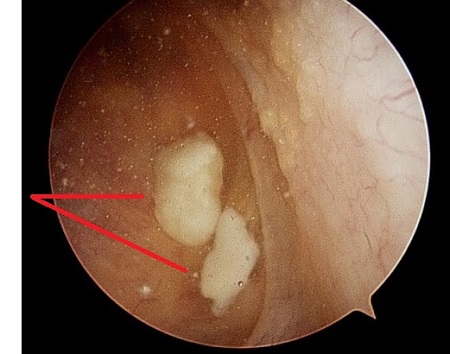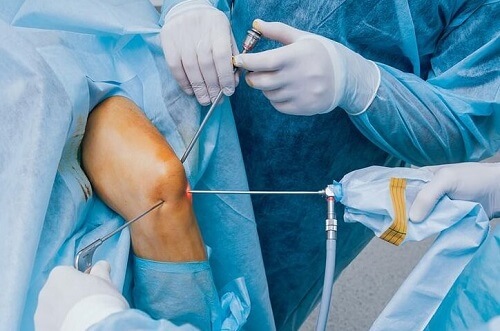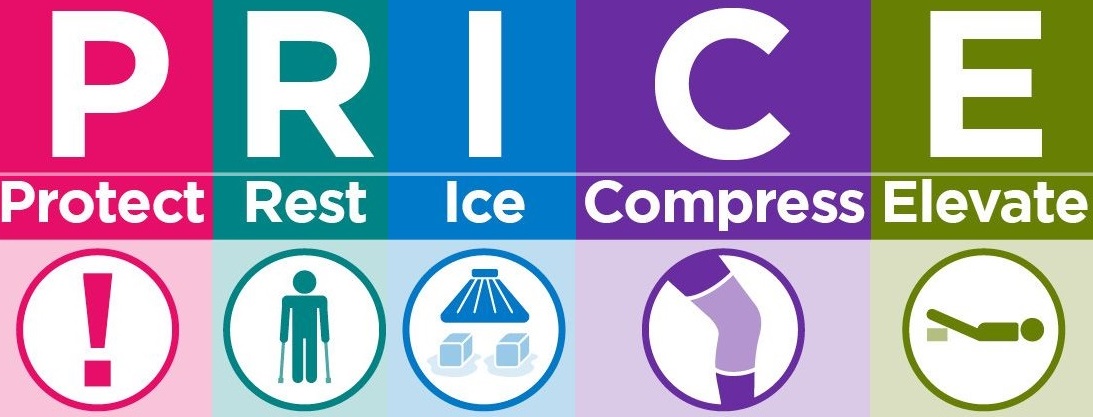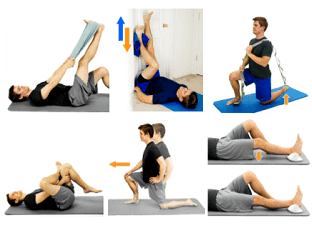- Home
- Knee Symptoms
- Knee Locking
- Locked Knee Treatment
Locked Knee Treatment
Written By: Chloe Wilson, BSc(Hons) Physiotherapy
Reviewed by: KPE Medical Review Board

A locked knee is where the knee cannot properly either bend or straighten.
When a knee locks up it gets stuck in one position, unable to move at all, either due to extreme pain or something being stuck in the joint blocking movement.
Knee locking can be really painful and may affect daily activities such as walking, getting in and out of a chair and walking up and down the stairs.
What Causes A Locked Knee?
There are two types of locked knee:
1. True Knee Locking
With true locking, something is physically inside the knee joint impeding movement, whereas with pseudo locking, the body tries to protect itself by preventing any movement.
True knee locking is usually caused by a:
- Bucket Handle Meniscus Tear: where a large torn section of cartilage gets wedged in the knee joint so it can’t move, like when something gets caught in a zipper
- Loose Body: where a fragment of bone or cartilage breaks off, floats around and gets caught in the knee joint. A loose body is also known as a “knee mouse”.
True knee locking is usually caused by a knee injury, such as sudden twisting of the knee, or knee arthritis, and may or may not be painful. LEARN MORE >
2. Pseudo Knee Locking
A pseudo locked knee happens when knee pain is so severe that the leg muscles spasm and tighten in an attempt to protect the joint. This automatic defence mechanism helps to prevent further damage by restricting knee movement.
Pseudo knee locking is usually the result of a knee injury, swelling, patellar maltracking or knee plica syndrome.
How To Unlock A Locked Knee
So the first question is, how do you unlock a locked knee? Well, that's going to depend on whether it is truly locked or not.

With a truly locked knee, movement is completely restricted and you are physically unable to bend or straighten the knee until the fragment moves out of the joint.
Some people find that they can get it their knee to unlock by gently "waggling" their knee around in different directions as this can move the cartilage flap or knee mouse out of the joint.
However, the knee will almost certainly lock up again in the future as the fragment floats back into the joint and may need to be removed surgically.
The difference with pseudolocking is that knee movement isn't physically blocked, but it may be very painful. There tends to be more of a "catching" or brief locking sensation rather than the knee locking up completely and the knee may feel unstable.
With a pseudo locked knee, usually, after resting in a comfortable position for a few moments and gently bending and straightening the knee, the knee will relax enough for you to be able to move it again.
Locked Knee Treatment
Most cases of a locked knee do not require surgery but effective treatment depends on accurate diagnosis. Your doctor will examine your knee movements and may send you for tests such as an MRI, CT scan or x-ray to determine what is going on.
Typical locked knee treatment involves:
1. PRICE
The first line of treatment for a locked knee is to follow PRICE principles:
- Protect: the knee from further damage e.g. using crutches
- Rest: appropriately – avoid aggravating activities, but try and keep the knee moving within its pain-free range to prevent secondary problems such as weakness and stiffness
- Ice: Regularly applying ice packs helps to reduce the knee swelling often associated with a locked knee
- Compression: Wearing a tubigrip compression bandage helps to support the knee and reduce swelling
- Elevation: when sitting or lying down, keep the knee raised, ideally higher than your heart so that any swelling can drain out of the knee
2. NSAID’s
Non-steroidal anti-inflammatory medications can help reduce pain and swelling from a locked knee. Over the counter medications such as ibuprofen and naproxen may be sufficient, if not your doctor may be prescribe something stronger.
3. Cortisone Injections
Corticosteroid injections may be recommended as part of your locked knee treatment. Your doctor injects a mixture of local anaesthestic and corticosteroid into the knee joint to help reduce pain and swelling. LEARN MORE >
4. Exercises
Strengthening and mobility exercises are a vital part of locked knee treatment. Regaining full strength, stability and movement in the knee will help to stop pseudo knee locking and get you back to your normal activity levels. LEARN MORE >
SAFETY ADVICE: If your knee locks and you can’t unlock it or it repeatedly locks up, seek medical advice.
Surgery For Knee Locking
If the knee is permanently locked or there is persistent intermittent knee locking, then surgery is usually advised.
Surgery for knee locking is typically done when there is a large bucket handle meniscus tear, a bone fragment or knee mouse getting stuck in the joint.
Knee Arthroscopy
A knee arthroscopy is the surgery of choice with a truly locked knee. This is minimally invasive knee surgery where two or three small holes are made around the knee.

A tiny camera known as an arthroscope, connected to a screen, is inserted into the knee joint through one of the holes so that the surgeon can view the knee joint and any damage.
Sterile saline is pumped into the knee to make it easier for the surgeon to see.
Special micro tools are then inserted and used to remove any loose fragments of cartilage of bone.
The saline is then drained from the knee and the incisions are sewn up with sutures.
Locked knee surgery may be carried out under local anesthetic, spinal block or general anesthesia depending on your medical history, and usually takes less than an hour.
Recovering From Locked Knee Surgery
Most people make an excellent recovery from locked knee surgery. You can usually get up and about quickly and go home the same day, but some people may need to use crutches for a few days after a knee arthroscopy. It helps to use ice regularly for the first few days and keep the leg elevated to help reduce any swelling, both of which help to reduce pain, speed up healing and improve function.
You will be given an exercise programme to do at by your doctor or physical therapist. It is really important to regain full range of motion and strength in the knee. By doing simple exercises you can ensure you get the most benefit from your locked knee surgery. LEARN MORE >
10 Second Summary
- A locked knee is caused by something getting stuck in the knee joint, most typically a piece of knee cartilage or a fragment of bone
- There are two types of knee locking - true knee locking and pseudo knee locking
- Knee locking is often intermittent
- The best treatment options for a locked knee are: PRICE, medication, knee injections, exercises and in some case surgery
Page Last Updated: 11/01/23
Next Review Due: 11/01/25






